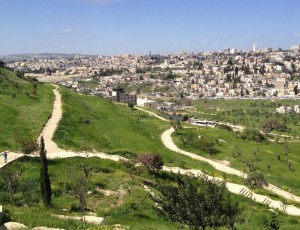File this one in the “who knew?†department.
During the intermediary days of Passover, my wife and I had the opportunity to join a guided tour through the Tzurim Valley that begins at the Mount Scopus campus of Hebrew University and ends at the Dung Gate entrance to the Old City, opposite the Western Wall. The route – more an easy walk than a hike – includes so many surprises, that it’s a wonder it isn’t on everyone’s Israeli traveling agenda (we’d never even heard of it).
Surprise number one: there is a blue and white marked trail that leads through a mostly untouched, Judean valley full of olive, oak and “Judas†trees and, at this time of year, red poppies and lots of greenery – not what you’d expect in the heart of East Jerusalem with its ever-present view of the glinting gold Dome of the Rock.
The trail leads past a “sifting tent†where rubble from the excavation of the Solomon’s Stables area of the Temple Mount has been transported to allow visitors to try their hand at archaeology-made-simple. Work by the Islamic Wakf to build a mosque where the Biblical-era Stables once stood caused an outcry in the archaeology community when the remains – full of Second Temple treasures – was found dumped outside the Old City walls.
In the sifting tent, the dirt is placed into raised containers to make it easier for families (there were many children) to poke through. We didn’t try our hand…there was much more to see.
Surprise number two: there is a gorgeous park situated midway along the path named after early Mormon leader, Orson Hyde, and built as part of the mid-1980’s deal that allowed for the creation of the Jerusalem Center for Near Eastern Studies. A perfect place for picnicking, the park is large, lush and mostly deserted. Perhaps I shouldn’t have told you that.
Descending out of Tzurim Valley (a National Park since 1988) and into the Kidron Valley, we reached the Gethsemane Church and its adjacent gardens. The gardens are open free of charge from 9:00 AM – noon and then again from 2:00 PM until the sun sets.
The concluding segment of the journey overlooks the Mount of Olives – not a surprise – but also a number of Jewish tombs – one for Absalom (the rebellious son of King David) and another for the prophet Zechariah, who in all likelihood is not actually buried there: Zechariah preached during the First Temple-era, but graves from that time are located on the western side of the Old City. The tomb itself is carved out of solid rock, much like Petra, although not as colorful or on as grand a scale.
Our tour – led by a Naomi Ehrlich, a charming, competent and occasionally outspoken Israeli tour guide – lasted about three hours, which included many stops for explanation and snacking. You can easily walk it in half the time and the path is well marked. Naomi offers the tours during the Passover and Sukkot holidays through the Jerusalem AACI (Association of Americans and Canadians in Israel).
Of course, if your politics prevent you from walking through East Jerusalem, you’ll have to forgo this extraordinarily beautiful and fascinating adventure. The Tzurim Valley Park itself is controversial (note the ongoing tensions over the creation of the nearby Mount Scopus Slopes National Park) and the sifting tent is run by El’ad, which also backs the City of David archaeological site.
I’d recommend putting such proclivities aside – at least for a couple of hours – to enjoy one of the region’s as yet mostly undiscovered delights.
I wrote about our tiyul last week on Israelity.



